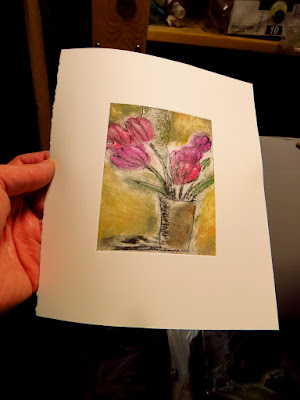Finally found time this year to return to the studio and pursue a few ideas I have been wanting to translate to prints.
Shoreline is a new study that originates from a drawing I did while touring the north shore of Lake Superior. It is a small image that measures 8.5 x 8. 5 cm (3.5 x 3.5 inches). It was originally intended to be a collagraph, but reality struck when I realized the small size would be very difficult to construct a plate especially with the fine details in the rock, trees and island. So a decision was made to interpret it as a drypoint.
I transferred my sketch on matboard plate onto clear acrylic plexiglass (perspex) and using a fine point needle scratched lines into the surface. I wanted additional texture in the foreground rocks and achieved this by applying pressure using the back of a metal spoon rubbed onto the back of a small piece of cut coarse sandpaper.
Akua intaglio ink (carbon black and a hint of white mixed in) was wiped into the lines and damp cotton rag paper was set over top. I printed about four of these. My plan is to apply hand-colouring to these prints when they are dry.
The next phase was to combine a monotype on the surface of a second plate (equal size of the drypoint plate). The monotype was made on thin acetate using rolled thinned colours of etching inks onto the surface. I then used cotton swabs, pencil point and bristle of small brushes to remove ink and make marks.
However I had only printed two versions using both plates and noticed off registration occurring in each. I made notes during the process.
Observations
The 3mm key plate had been filed along the edges at a 45 degree angle.
The thinner acetate plate was cut to the same dimensions as the other plate. It did not have a angled edge.
Bristol card was used a bed liner and registration template for the plates. I had anchored the edges of the template with small tabs of painters tape onto the acrylic bed. The plexiglass plate was traced in light pencil on the template. Another light pencil outline as made several inches outside the plate position marks that I could use to line up the print paper.
- Perhaps shifting was occurring when I passed the plates under the press roller?
- Was the coated side of the bristol card not providing enough grip and possibly not creating an indentation in the surface from the plate under pressure?
- Should I use another material for a press liner such as mat board? Was the off register being created when the plate was meeting the roller?
 |
| misalignment of plates noticeable on sides |
Possible Solutions
Pass an inkless plexiglass plate through the press with enough pressure to see if it might make an indentatin mark in the Bristol card.
Trim the acetate sheet to fit the inside dimensions of the indentation in the registration sheet. This would allow the bevel edges from the main plate to emboss as a clean edge with no carry over of ink.
Forego the monotype plate. A fellow printmaker from an online community suggested that I try inking/wiping the plate and then applying a relief roll of thinned inks on the surface.
Success with single plate approach
I decided to take the advice and try the relief roll. This time around I used Caligo Safewash etching inks. I applied two colours with small brayers. For the sky I used a blue mixed from a combination of prussian blue with a little white modified with medium. The colour for the foreground rock was a combination of three process colours (magenta, yellow and cyan) with a little white and modifier to make it transparent.
The surface was carefully worked into with cotton swabs (clouds) and using the tip of a pencil to make tiny lines in the blue ink (above the rocks) that created the effect of light on the water surface and the horizon line.
I was pleased with the result when the print on paper was revealed after passing the plate under roller. And also no slipping or angling of my plate as I reversed the bristol template and had used the uncoated side to lay the plate onto.
My lesson learned here was that being patient and having a spirit of adventure can sometimes yield a favourable outcome.























































